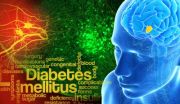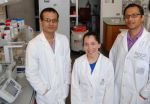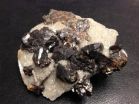(Press-News.org) Researchers at Yale School of Medicine have pinpointed a mechanism in part of the brain that is key to sensing glucose levels in the blood, linking it to both type 1 and type 2 diabetes. The findings are published in the July 28 issue of Proceedings of the National Academies of Sciences.
"We've discovered that the prolyl endopeptidase enzyme — located in a part of the hypothalamus known as the ventromedial nucleus — sets a series of steps in motion that control glucose levels in the blood," said lead author Sabrina Diano, professor in the Departments of Obstetrics, Gynecology & Reproductive Sciences, Comparative Medicine, and Neurobiology at Yale School of Medicine. "Our findings could eventually lead to new treatments for diabetes."
The ventromedial nucleus contains cells that are glucose sensors. To understand the role of prolyl endopeptidase in this part of the brain, the team used mice that were genetically engineered with low levels of this enzyme. They found that in absence of this enzyme, mice had high levels of glucose in the blood and became diabetic.
Diano and her team discovered that this enzyme is important because it makes the neurons in this part of the brain sensitive to glucose. The neurons sense the increase in glucose levels and then tell the pancreas to release insulin, which is the hormone that maintains a steady level of glucose in the blood, preventing diabetes.
"Because of the low levels of endopeptidase, the neurons were no longer sensitive to increased glucose levels and could not control the release of insulin from the pancreas, and the mice developed diabetes." said Diano, who is also a member of the Yale Program in Integrative Cell Signaling and Neurobiology of Metabolism.
Diano said the next step in this research is to identify the targets of this enzyme by understanding how the enzyme makes the neurons sense changes in glucose levels. "If we succeed in doing this, we could be able to regulate the secretion of insulin, and be able to prevent and treat type 2 diabetes," she said.
INFORMATION:
Other authors on the study include Jung Dae Kim, Chitoku Toda, Giuseppe, D'Agostino, Caroline J. Zeiss, Ralph J. DiLeone, John D. Ellsworth, Richard G. Kibbey*, Owen Chan, Brandon K. Harvey, Christopher T. Richie, Mari Savolainen, Timo Myöhännen, and Jin Kwon Jeong.
The study was funded by the National Institutes of Health (DK084065 and DK097566), and the American Diabetes Association.
Citation: PNAS http://www.pnas.org/cgi/doi/10.1073/pnas.1406000111
Glucose 'control switch' in the brain key to both types of diabetes
2014-07-28
ELSE PRESS RELEASES FROM THIS DATE:
Physicists unlock nature of high-temperature superconductivity
2014-07-28
Physicists have identified the "quantum glue" that underlies a promising type of superconductivity -- a crucial step towards the creation of energy superhighways that conduct electricity without current loss.
The research, published online in the Proceedings of the National Academy of Sciences, is a collaboration between theoretical physicists led by Dirk Morr, professor of physics at the University of Illinois at Chicago, and experimentalists led by Seamus J.C. Davis of Cornell University and Brookhaven National Laboratory.
The earliest superconducting materials required ...
Google searches hold key to future market crashes
2014-07-28
A team of researchers from Warwick Business School and Boston University have developed a method to automatically identify topics that people search for on Google before subsequent stock market falls.
Applied to data between 2004 and 2012, the method shows that increases in searches for business and politics preceded falls in the stock market. The study, 'Quantifying the semantics of search behavior before stock market moves,' was published in the Proceedings of the National Academy of Sciences.
The researchers suggest that this method could be applied to help identify ...
Memory relies on astrocytes, the brain's lesser known cells
2014-07-28
VIDEO:
Salk scientists have discovered the link between astrocytes and memory.
Click here for more information.
LA JOLLA—When you're expecting something—like the meal you've ordered at a restaurant—or when something captures your interest, unique electrical rhythms sweep through your brain.
These waves are called gamma oscillations and they reflect a symphony of cells—both excitatory and inhibitory—playing together in an orchestrated way. Though their role has been debated, ...
Scientists discover genetic switch that can prevent peripheral vascular disease in mice
2014-07-28
Millions of people in the United States have a circulatory problem of the legs called peripheral vascular disease. It can be painful and may even require surgery in serious cases. This disease can lead to severe skeletal muscle wasting and, in turn, limb amputation.
At The University of Texas Health Science Center at Houston (UTHealth) Medical School, scientists tested a non-surgical preventative treatment in a mouse model of the disease and it was associated with increased blood circulation. Their proof-of-concept study appears in the journal Cell Reports.
Unlike ...
Mineral magic? Common mineral capable of making and breaking bonds
2014-07-28
TEMPE, Ariz. - Reactions among minerals and organic compounds in hydrothermal environments are critical components of the Earth's deep carbon cycle, they provide energy for the deep biosphere, and may have implications for the origins of life. However, very little is known about how minerals influence organic reactions. A team of researchers from Arizona State University have demonstrated how a common mineral acts as a catalysts for specific hydrothermal organic reactions – negating the need for toxic solvents or expensive reagents.
At the heart of organic chemistry, ...
Forced mutations doom HIV
2014-07-28
CAMBRIDGE, MA -- Fifteen years ago, MIT professor John Essigmann and colleagues from the University of Washington had a novel idea for an HIV drug. They thought if they could induce the virus to mutate uncontrollably, they could force it to weaken and eventually die out — a strategy that our immune system uses against many viruses.
The researchers developed such a drug, which caused HIV to mutate at an enhanced rate, as expected. But it did not eliminate the virus from patients in a small clinical trial reported in 2011. In a new study, however, Essigmann and colleagues ...
Tennessee Surgical Quality Collaborative saves 533 lives and $75 million in 3 years
2014-07-28
NEW YORK (July 28, 2:45 pm [ET]): Ten hospitals in the Tennessee Surgical Quality Collaborative (TSQC) have reduced surgical complications by 19.7 percent since 2009, resulting in at least 533 lives saved and $75.2 million in reduced costs, according to new results presented today at the American College of Surgeons National Surgical Quality Improvement Program (ACS NSQIP®) National Conference in New York City.
The hospital collaborative was formed in 2008 as a partnership of the Tennessee Chapter of the American College of Surgeons and the Tennessee Hospital Association's ...
Stimulation of brain region restores consciousness to animals under general anesthesia
2014-07-28
Stimulating one of two dopamine-producing regions in the brain was able to arouse animals receiving general anesthesia with either isoflurane or propofol. In the August issue of Anesthesiology, investigators from Massachusetts General Hospital (MGH) report that rats anesthetized with continuous doses of either agent would move, raise their heads and even stand up in response to electrical stimulation delivered to the ventral tegmental area (VTA). Stimulation of the other major dopamine-releasing area, the substantia nigra, did not induce the animals to wake up.
"Dopamine ...
Study suggests disruptive effects of anesthesia on brain cell connections are temporary
2014-07-28
A study of juvenile rat brain cells suggests that the effects of a commonly used anesthetic drug on the connections between brain cells are temporary.
The study, published in this week's issue of the journal PLOS ONE, was conducted by biologists at the University of California, San Diego and Weill Cornell Medical College in New York in response to concerns, arising from multiple studies on humans over the past decade, that exposing children to general anesthetics may increase their susceptibility to long-term cognitive and behavioral deficits, such as learning disabilities.
An ...
UTSW cancer researchers identify irreversible inhibitor for KRAS gene mutation
2014-07-28
DALLAS – July 28, 2014 – UT Southwestern Medical Center cancer researchers have found a molecule that selectively and irreversibly interferes with the activity of a mutated cancer gene common in 30 percent of tumors.
The molecule, SML-8-73-1 (SML), interferes with the KRAS gene, or Kirsten rat sarcoma viral oncogene homolog. The gene produces proteins called K-Ras that influence when cells divide. Mutations in K-Ras can result in normal cells dividing uncontrollably and turning cancerous. These mutations are particularly found in cancers of the lung, pancreas, and colon. ...





